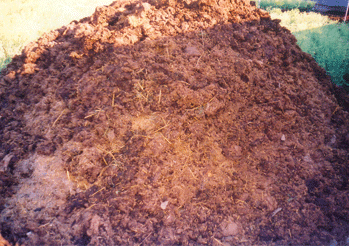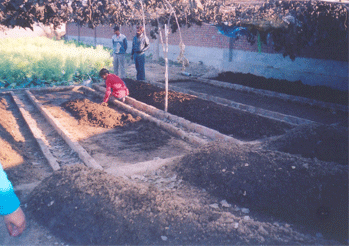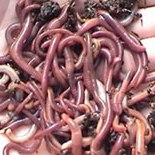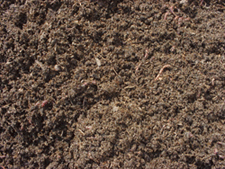|
Vermicompost is an organic manure
(bio-fertilize) produced as the vermicast by earth worm feeding on
biological waste material; plant residue. Earthworms are small, soft,
cylindrical bodied invertebrates that play a vital role in soil
ecosystem maintenance. Aristotle referred to them as 'intestines of
the earth' because of their habit of ingesting and ejecting the soil.
Earthworms greatly influence soil properties and cast production,
which results in the continuous turnover of the soil and mixing of
minerals and organic constituents.
Worms that live in the soil are the
farmer's and gardener's friends. They consume dead organic matter and
turn it into rich and fertile humus with added natural nutrients. One
species of worm, the Californian Red Worm, is particularly productive
at making humus, reproduces vigorously, is easy to breed and has good
longevity. Through their feeding and burrowing
activities earthworms incorporate surface organic matter, spatial
distribution of soil, improve porosity and soil airation increase
water infiltration, encourage plant root growth improve soil aggregate
stability, enhance nutrient availability and reduce incidence of root
diseases.

Vermicompost, the
end product, is extremely useful for enriching and fertilising the
soil. It is odourless and safe to handle. It is rich in hormones,
antibiotics and vitamins that produce healthy plant growth.
Although its nitrogen, phosphorus and potassium values are not as
high as for chemical fertilisers, it is a multi-purpose compost
that provides all the ingredients needed to improve most soils and
is much better for the environment as well. By contrast, to
improve poor soils chemical fertilisers are not enough by
themselves and other materials need to be applied as well.
Vermicompost is
also seven times richer than compost that has been rotted without
introduction of worms, so only one seventh of the quantity is
needed to enrich the soil. Tests in India have shown that
vermicompost application can double wheat yields and quadruple
yields of fodder. For best effect vermicompost needs to be applied
before the growing season over a two or three year period.

Vermicompost can be used for
organic cultivation of crops as it do not have any toxic residue
effect. It is cheap and easy to produce Vermicompost. It does not
small like manure but just like healthy rich soil.
Casting of earthworms contain a high percentage of humus. Humus helps
soil particles from into clusters, which create channels for the
passage of air and improve its capacity to hold water. Humic acid
present in humus, provides binding sites for the plant nutrients but
also releases them to the plants upon demand. This also aids in the
prevention of harmful plant pathogens, fungi, nematodes and bacteria.
Earthworms are
invertebrates, which means they have no back bone (unlike
snakes, which do have a back bone). Earthworms are annelids
and are members of the class Oligochaeta, because they crawl
using circular and longitudinal muscles which are located under
the epidermis. Each segment also has bristle like setae (see
figure 1) which help to anchor their segments as they crawl.
Unlike humans, earthworms do not have a well developed
respiratory system. Instead of lungs, they breathe through their
skin which needs to stay moist for breathing.
Earthworms are annelids, which means their bodies are segmented.
Earthworms have bilateral symmetry, which means if you cut an
earthworm down centre, you would find that the left and right
sides the its body are identical (mirror images of each other).
The first segment is specially named the peristomium (see figure
1) and contains the mouth. There is a small tongue-like lobe
just above the mouth called the prostomium (see figure 1). The
prostomium is used by the earthworm to see its environment -
as earthworms have no eyes, ears, nose or hands, it depends on
the prostomium and skin to help it feel its way through the
soil. As the earthworm tunnels through the soil, it excretes
mucus from its body. This mucus reacts with the soil of the
tunnel walls and forms a type of cement which makes the tunnel
walls stable so that the tunnel can be reused.
About one third of the way down the earthworm (from the head) is
the clitellum (see figure 1). The clitellum is a swelling of the
skin and can only be seen in earthworms that are ready to
reproduce. It may be white, orange-red or reddish-brown in
colour. Earthworms are ready to mate when their clitellum is
orange. Most of the material secreted to form earthworm cocoons
is produced within the clitellum. The number of the segments to
where the clitellum begins and the number of segments that make
up the clitellum are important for identifying earthworms.
The very last segment is called the periproct (see figure 1) and
contains the anus.
Except for the first and last segment all the other segments
have eight setae located around each segment. The setae look
like small bristles sticking out of the earthworms skin. The
setae can be retracted and are for moving through the soil. The
bristle-like setae anchor the segments as they crawl.
Specification
|
·
pH |
6.5-7.5 |
|
·
Organic Carbon |
17.50 30.31 % |
|
·
Nitrogen |
0.80 2.05 % |
|
·
Phosphorus |
0.70 1.93 % |
|
·
Potassium |
0.30 1.50 % |
|
·
Carbon : Nitrogen |
14-15 : 1 % |
|
·
Calcium |
1.50 4.5 % |
|
·
Magnesium |
0.2 0.7 % |
|
·
Sodium |
0.02 0.30 % |
|
·
Sulphur
|
Traces to 0.40 % |
|
·
Iron |
0.08 0.7 % |
|
·
Zinc |
0.028 0.036 % |
|
·
Manganese |
Traces to 0.40 % |
|
·
Copper |
0.0027 0.0123 % |
|
·
Boron |
0.0034 0.0075 % |
|
·
Aluminum |
Traces to 0.071 % |
|
·
Cobalt, Molybdenum |
Present in available form |
Biological
Total bacter count of 2.5 ΄ 106 comprising of Azotobacter, PGPR,
PSB, Actinomycetes. Also
contains Gibberalline, Auxins & Cytokinine in sufficient
quantities.
Contains sufficient moisture (25-35%) at the time of packing.
SCEINTIFIC VERMICULTURE BY
AGRICARE ORGANIC FARMS
| Type of
Culture |
Rate
(Per Kg) |
Genetic
Purity |
No. of Worms |
Eggs
Percentage |
| Foundation
Vermiculture F1 |
650/Kg |
98% |
1000/Kg |
50% |
| Foundation
Vermiculture F2 |
500/Kg |
94% |
1000/Kg |
40% |
| Foundation
Vermiculture Pedigee |
350/Kg |
85% |
Unpredictable |
25% |
| General
Vermiculture |
150/Kg |
60% |
Unpredictable |
12% |
Discount on larger quantities
may be considered accordingly.
Advantages of Vermicompost
.
 Minimizes need for
chemical fertilizers, makes the soil healthy Minimizes need for
chemical fertilizers, makes the soil healthy
with high NPK content and yields crops of better quality.
. Agricultural and kitchen wastes are put to good use.
· Can be done at a smaller scale and at a faster rate than other
methods of composting.
· Can be done for commercial purposes as well as for use on one's
own farm.
· Surplus earthworms can be converted into good livestock feed.
The Diverse Uses of Worms
Worms that live in soil are not just
useful for making humus, or as fishing bait, which is another
common use. Other uses include:
-
Drying and
grinding of the flesh of the worm to produce a high protein
powdered food additive used, for example, in hamburgers,
sausages and other minced meat products, and as an additive to
animal feed (for horses, rabbits and chickens, for example) to
provide nutritional balance
-
As live food
for rearing fish and frogs
-
Extracting
collagen from the worms for pharmaceuticals
-
Making
antibiotics from the ceolomic liquid (the fluid that transports
nutrients and respiratory gases through a worm's body) extracted
from the worms
-
Research into
how the skin of worms repairs itself to discover if this can be
used for repair of damaged skin for people and whether
substances obtained from worms can strengthen a person's auto
immune system
Production
 It
can be produced in bins, pits or
troughs either below or above the soil surface, using bricks or stone
slabs or even plastics. If the pits are over it as moisture in the
thatched roof should be built over it as moisture in the 40-50% range
and temperature in the 20-30° C range need to be maintained. Any
organic waste or agricultural residue can be used as feed mixture,
etc. farmyard wastes, green wastes, sugarcane theash, kitchen wastes
etc. They should be mixed with cow dung in the ratio of 8:1. Once the
feed mixture is seen to largely contain casts, then it is dumped in
conical heap for few hours. The worms collect at base and can be
easily retrieved for reuse. The rest of the dried material is passed
through a 3 mm sieve to collect the casts as vermicompost. It
can be produced in bins, pits or
troughs either below or above the soil surface, using bricks or stone
slabs or even plastics. If the pits are over it as moisture in the
thatched roof should be built over it as moisture in the 40-50% range
and temperature in the 20-30° C range need to be maintained. Any
organic waste or agricultural residue can be used as feed mixture,
etc. farmyard wastes, green wastes, sugarcane theash, kitchen wastes
etc. They should be mixed with cow dung in the ratio of 8:1. Once the
feed mixture is seen to largely contain casts, then it is dumped in
conical heap for few hours. The worms collect at base and can be
easily retrieved for reuse. The rest of the dried material is passed
through a 3 mm sieve to collect the casts as vermicompost.
Vermicast vs.
Chemical Fertilizers in Soil
|
Criteria for Comparison |
Chemical Fertilizers |
Vermicast |
|
Macro nutrient contents |
Mostly contains only one (N in urea) or at the most two (N &
P in DAP) nutrients in any one type of chemical fertilizer |
Contains all i.e. nitrogen (N), phosphorus (P) & potassium
(K) in sufficient quantities |
|
Secondary nutrient contents |
Not available |
Calcium (Ca), magnesium (Mg) & sulphur (S) is available in
required quantities |
|
Micro nutrient contents |
Not available |
Zinc (Zn), boron (B), manganese (Mn),
iron (Fe), copper (Cu), molybdenum (Mo) and chlorine (Cl)
also present |
|
pH balancing |
Disturb soil pH to create salinity and alkalinity conditions |
Helps in the control of soil pH and checks the salinity and
alkalinity in soil |
|
EC correction |
Creates imbalance in soil EC affecting nutrients
assimilation |
Helps in balancing the EC to improve plant nutrient
adsorption |
|
Organic carbon |
Not available |
Very high organic carbon and humus contents improves soil
characteristics |
|
Moisture retention capacity |
Reduces moisture retention capacity of the soil |
Increases moistures retention capacity of the soil |
|
Soil Texture |
Damages soil texture to reduce aeration |
Improves soil texture for better aeration |
|
Beneficial bacteria & fungi |
Reduces biological activities and thus the fertility is
impaired |
Very high biological life improves the soil fertility and
productivity on sustainable basis |
|
Plant growth hormones |
Not available |
Sufficient quantity helps in better growth and production |
Economic Evaluation: Vermicast vs. Chemical Fertilizers
Generally
cost comparisons for different fertility inputs are carried out on per
unit of cultivated area basis. However, the correct methods for
comparison should be either the cost per unit of output or the cost
per unit of fertility inputs. Here a comparison has been made on the
basis of cost per unit of fertility inputs provided through chemical
fertilizers Vs. vermicast.
Cost of Chemical Fertilizer Use
Presently
chemical fertilizers are used for providing nutrients such as
nitrogen, phosphorous and potash. The cost of these chemical
fertilizers in the context of their plant uptake i.e. fertilizers use
efficiency are estimated as follows.
Urea
-
Say 100 kg of
urea is used per hectare, containing 46% nitrogen.
-
Cost of urea
is Rs.4.50/- per kg and thus cost of nitrogen is Rs.9.80/- per
kg.
-
Plant uptake
i.e. use efficiency is 15-40 percent (average 20%) for nitrogen.
-
Therefore, the
cost of nitrogen actually used by the plants is Rs.49.00 per kg.
DAP
-
Say 100 kg of
DAP is used per hectare.
-
This contains
18 percent nitrogen and 46 percent phosphorus.
-
Cost of DAP is
Rs.8.50/- per kg and thus the cost of nutrients (combined for
nitrogen plus phosphorus) is Rs.13.30/- per kg.
-
Plant uptake
i,.e. use efficiency is 15-40 percent for nitrogen (average 20%)
and 10-25 percent for phosphorus (average 15%).
-
The cost of
nutrients actually used by the plants from DAP is Rs.75.94/- per
kg.
SSP
-
Say 100 kg of
SSP is used per hectare, containing 16% phosphorus.
-
Cost of SSP is
Rs.2.60/- per kg and thus cost of phosphorus is Rs.16.25/- per
kg.
-
Plant uptake
i.e. use efficiency is 10-25 percent for phosphorus (average
15%).
-
The cost of
phosphorus actually used by the plants is Rs.108.82/- per kg.
CAN
-
Say 100 kg of
CAN is used per hectare, containing 20% nitrogen.
-
Cost of CAN is
Rs.4.20/- per kg and thus the cost of nitrogen is Rs.21.00/- per
kg.
-
Plant uptake
i.e. use efficiency is 15-40 percent (average 20%).
-
The cost of
nitrogen actually used by the plants is Rs.1005.00/- per kg.
Cost of Vermicast Use
In case of vermicast, over 70 percent is
consumed by the farmers through their in-house production. For
remaining, the farmers are buying vermicast from commercial
production units at an average price of Rs.2000/- per metric tone.
1.
The average nutrients contents reported for vermicast are
nitrogen-1.5 to 2.5 percent (average 2%), phosphorus-1.25 percent
(average 1.75%), potash-1.00 to 2.00 percent (average 1.5%).
2.
In addition vermicast contains all micronutrients and trace
elements, that would also add up to atleast one percent equivalent
of nutrients.
3.
The vermicast has active biological life containing
Azatobactor, PSB, PGPR, etc. During 90-100 days of crop duration
they also add up to 1.5 to 2.5 percent nutrients (average 2%).
4.
Say 1000 kg of vermicast is used per hectare.
5.
The total nutrients provided by 1000 kg of vermicast will
add up to 82.50 per kg (8.25%) and at an average plant uptake i.e.
use efficiency of 65 percent will provide 53.60 kgs of nutrients.
6.
At an average cost of vermicast at Rs.2000/- per MT per
hectare, the cost of nutrients is Rs.37.00/- per kg.
In addition
to nutrients, vermicast will also provide better aeration, water
retention capacity and many other benefits. Some of the major
advantages of vermicast use are also the lower cost of labour
(saving due to lesser weeds in the field) and saving from the cost
of treatment for termites.
Vermicast on subsequent use has been found to provide at least
20-30 percent more nutrients. This ability can continuously reduce
the quantities of vermicast used in the field over long durations.
From the above the actual nutrient used and the cost incurred for
various chemical fertilizers, it clearly indicates that the
chemical fertilizers are more expensive than vermicast.
The use of chemicals has also been promoted by large amounts of
subsidies that enabled them to be used as nutrients for crops.
Economics (One Bed)
A. Capital Cost of 100 beds
Item Cost (Rs.)
Vermiculture cost@ Rs 600/kg for 100
beds 1500000
1 Construction of a temporary shed for setting up 400 tpa vermi-compost
unit 120,000
Implement and Machinery for a 400 tpa unit 80,000
3 Office cum store 120000
4 Water source 40000
Total 1860,000
B. Recurring Cost
Item Cost (Rs.)
1 Feed stock & handling cost @ Rs. 30,000 per cycle for 6 cycle
in a year 1,80,000
2 Rent on lease @ Rs. 8,000 per year 8,000
Total 188000
(Operational cost of two cycles is capatalised)
Total Project Cost : Capital cost - Rs. 1860,000
Recurring cost - Rs. 188000
capitalized
Total Rs 2048000
5. Margin
20%
6. Bank loan
:80%
7. Rate of interest
: 12% pa
8. Repayment period
: 8 years including grace period of one year
9. Income
Item Rs.
(I year)
1 Sale of vermi-compost 400 tons @ Rs. 2000 per ton 800000
Total 8,00,000
Net Benefit 8,00,000-2048000= -1248000
(II year)
C. Recurring Cost
Item Cost (Rs.)
1 Feed stock & handling cost @ Rs60,000 per cycle for 6 cycle
in a year 36,0000
2 Rent on lease @ Rs. 8,000 per year 8,000
Total 3,68,000
1Additional Construction of a temporary shed for setting up
400tpa vermi-compost unit 1,20,000
Total input 4,88,000
1 Sale of vermi-compost 800 tons @ Rs. 2000 per ton 16,000,00
Less Total recurring
cost 4,48,000
Net Benefit 11,52,000
OVERALL PROFIT AFTER 2 YEARS
Net benefit of 2nd years- recovery for the 1st
year 11,52,000 1248000 =-96000
D. Recurring Cost Item Cost (Rs.)
1 Feed stock & handling cost @ Rs. 1,20,000 per cycle for 6
cycle in a year 7,20,000
2 Rent on lease @ Rs. 8,000 per year 16,000
Total 7,36,000
1 Additional Construction of a temporary shed for setting up
800tpa vermi-compost unit 2,40,000
Total input 9,76,000
1 Sale of vermi-compost1600 tons @ Rs. 2000 per ton 32,00,000
Less Total recurring
cost 9,76,000
Net Benefit 22,24,000
Overall
profit after deducting recovery= 22,24,000 96,000 = 21,28,000
note :
Margin of 20% is
assumed, but the actual margin will be as per the discretion of
the banks.
Interest rate of
12% is assumed, however, the actual rate will be as per banks'
discretion.
Similarly, the other economic / financial parameters such as
the repayment period, DSCR, IRR, etc., may also vary depending
upon the margin, interest rate, etc., taken into account by the
bank.
|